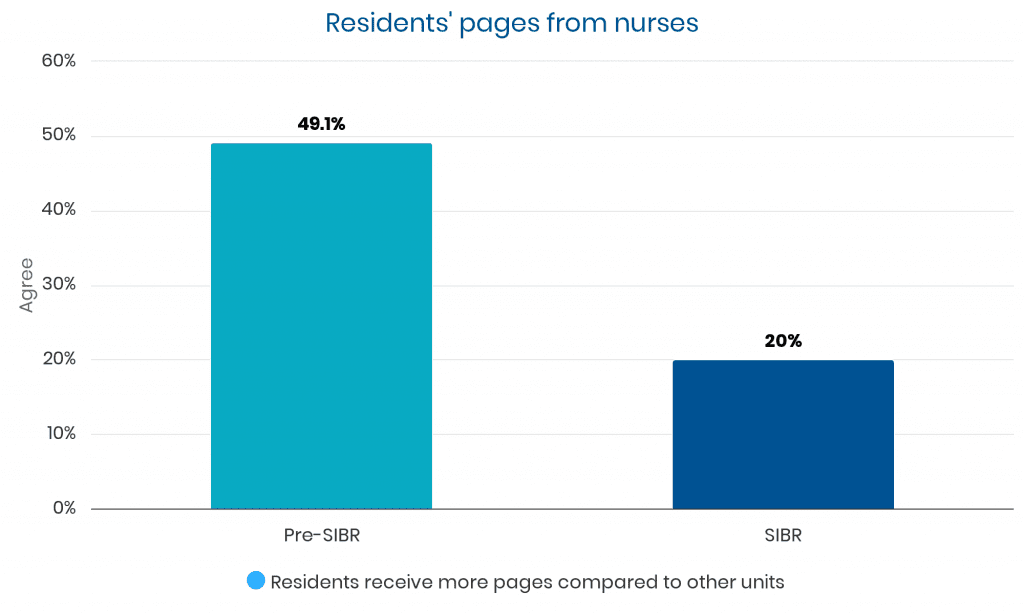Overview
The study conducted at Yale New Haven Health, a large academic medical center, assessed the impact of Structured Interdisciplinary Bedside Rounds (SIBR® rounds) on improving interprofessional communication (IPC) and workplace efficiency among residents and nurses on an inpatient internal medicine unit. The research aimed to address the gaps in effective IPC, which is crucial for patient safety and efficient care delivery.
Objectives
The objectives of this study were to:
- assess the fidelity of SIBR implementation on an inpatient teaching unit – meaning, how closely implementation processes aligned with planned processes;
- evaluate SIBR’s effect on resident physicians’ (hereafter referred to as ‘residents’) and nurses’ perceptions of IPC; and
- evaluate SIBR’s effect on residents’ perceived workplace efficiency.
Methods
The unit implemented the Accountable Care Unit (ACU care model) and SIBR rounds, with a robust engagement strategy involving multiple stakeholders. SIBR was implemented on the target unit in March 2017
and occurred Monday through Friday following resident teamwork rounds and nurses’ morning medication passes. The study included study with 88 residents and 44 nurses on a 32-bed, adult, general medicine inpatient teaching unit in a large, urban, academic medical center in New Haven, CT over 24 weeks in 2017. The study was a quasi-experimental design involving 88 residents and 44 nurses on a 32-bed inpatient internal medicine unit. Over 24 weeks, 1,308 SIBR encounters were observed. Surveys measured perceptions of IPC and workplace efficiency before and after SIBR implementation.
Results
The implementation of SIBR resulted in significant improvements in IPC and workplace efficiency:
- Enhanced IPC: Both residents and nurses reported a significant improvement in the quality of IPC, with a notable increase in the percentage of staff reporting good to excellent communication.
• IPC Perception Among Residents: Improved from 67.9% to 93.3% (P=0.024).
• IPC Perception Among Nurses: Improved from 36.0% to 73.7% (P=0.008).
- Increased Workplace Efficiency: The study noted a decrease in the frequency of pages to residents by nurses, suggesting smoother communication and reduced interruptions, which contributed to a more efficient working environment. Paging Frequency reduced from 49.1% to 20.0% of residents reporting more frequent paging compared to other units (P=0.01).
- Sustained Engagement: The high participation rates during the SIBR sessions reflected strong team engagement and commitment to the new communication protocol.
• SIBR Fidelity: Bedside nurse present for 96.7% of encounters, physician for 97.6%, and care manager for 94.7%.
Conclusion
The structured implementation of the ACU with SIBR rounds on the inpatient internal medicine unit significantly enhanced interprofessional communication and workplace efficiency. This intervention not only improved the immediate work environment but also set a foundation for better patient care coordination and safety. Future initiatives should continue to build on this model and assess the effect of SIBR on patient experience and clinical outcomes.
Additional Data


There was a significant increase in the Nurses’ and Residents’ rating of interprofessional communication after SIBR had been implemented.


After implementation of the ACU and SIBR rounds, Residents reported receiving fewer pages on the ACU unit compared with other units.
I hope you enjoyed reading these strong results. Unit outcomes like these are achievable within 3 to 6 months using a seasoned implementation methodology:
- skillful project management
- smooth training and launch, and a
- long-term partnership for sustainability.
One option to achieve similar results is to engage our 1Unit experts. Backed by 15 studies like this one, our work has received awards from The Joint Commission, CMS, Clinical Excellence Commission, IHI, BMJ, and the Society of Hospital Medicine.
Whether your unit(s) have current multidisciplinary rounds or not, our experts can guide your unit leaders to launch and sustain the best interdisciplinary teamwork and communication you’ve ever seen on a hospital ward.
This is not some ivory tower theory. Our methods have been toughened and refined worldwide. Everything we teach has been carefully tested over more than a decade, so we know it works.
Connect with us if you’d like the “Easy Button” to steadily reduce harm events, discharge delays, and patient and staff dissatisfiers.
Liam Chadwick, PhD



